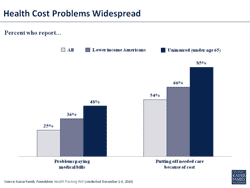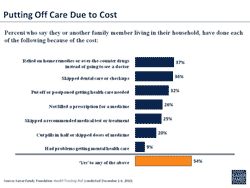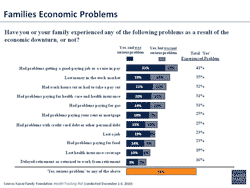Holiday Reminder
Like you, the holidays always make me think about those who are less fortunate. Last year around this time, I wrote a“Holiday Reminder” column about the health reform debate and people’s economic difficulties. The drive to pass the health reform law was struggling, and it would struggle even more in the following weeks after the senatorial special election in Massachusetts. I wondered whether we had lost track of what propelled health care to the top of the domestic agenda in the first place — people’s concerns about paying for health care in the middle of a deep recession.
Well, a year later, as we move through another holiday season, much has changed, yet much also remains the same. Congress passed the Patient Protection and Affordable Care Act — spurred in part by reports of big increases in individual health insurance premiums — yet the country continues to debate the merits of the law. We are technically out of the recession, though that means little to the millions of Americans who are out of work or who continue to struggle with their health care bills. Our new tracking poll shows that twenty-five percent of the public, thirty-six percent of low-income people, and forty-eight percent of the uninsured report problems paying their health care bills over the past year. Fifty-four percent of the American people — and a whopping eighty-five percent of the uninsured — report putting off medical care they believe they need because of cost during the same period, including skipping recommended treatments and not filling prescriptions.
More than half of the American people report a “serious” economic problem, such as difficulty getting a decent job, losing money in the markets, taking a cut in pay, or problems paying for health care, gas, rent or the mortgage. More than half! Difficulty paying for health care ranks fourth on the list of “serious problems experienced as a result of the downturn”, behind job-related issues and losing money in the markets. You can see the data in these three charts:
Click on charts to enlarge.
The public’s concerns about paying their health care bills were the reason we had the health reform debate in the first place. And, as I wrote a year ago, this is also where the health reform message went off track. When average Americans could not easily connect the legislation to their everyday problems of paying bills and making ends meet, they became more susceptible to messages from opponents ready to define the legislation in ways that were scary to the public. However, I am not entirely sure that different messaging would have made a big difference. Views on health reform largely track partisan and ideological differences in the country, and proponents and opponents were always going to play to people’s emotions — whether about the insurance industry (proponents) or about government (opponents). But, helping people understand how the reform law affects their everyday lives might have made a difference at the margin during the debate. And it could continue to, since the law and its implementation obviously remain hotly contested. I’m not sure people understand the degree to which expansions in Medicaid and tax credits will help lower income and working people pay for health insurance. Of course, these changes aren’t scheduled to take effect until 2014.
In the meantime, new rules go into effect next year that require insurers to spend a minimum percentage of their premium revenue on medical care rather than administration and profits, or pay rebates to consumers. And many states are taking more aggressive action to try to hold down premium increases. Their authority and capacity varies from state-to-state, and their efforts are generally limited to the non-group and small employer markets, but several states have had success holding back premium increases (at least temporarily). When states reject proposed rate increases, either insurers or providers have to divide up a smaller pie. The ensuing struggle between the two plays out differently depending upon the relative market power each has in a particular state or region. It would, of course, be better to directly address the fundamental causes of rising health care costs than to limit premium increases, which is the cost control equivalent of plugging a broken steam pipe: the pressure continues to build. But our ability to do that is limited — in some cases by politics and in other cases by how little we as experts know about which delivery and payment reforms will bear fruit — and current efforts will take many years to pay off. In the meantime these efforts by the states err on the side of putting people first, and could meaningfully help some people and small businesses by trying to place reasonable limits on the premium increases they pay.
Whatever your view of the health reform law or of these new state regulatory efforts, our December survey shows that large numbers of people continue to struggle with health care costs and that lower income and uninsured people struggle most of all. In Washington and in health policy circles, debates about how to control health costs are often intensely ideological. The numbers reported in our polls show why people look at health care costs very differently from the combatants in these debates. They are struggling and just want some relief. I doubt they would care much whether the strategy was a liberal, conservative or middle of the road one if they believed it would help them pay their bills.



